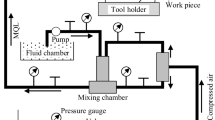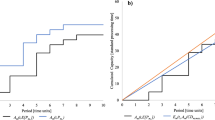Abstract
For high-value added products, machining tools’ lifespan significantly influences the quantity of procurement in machining process. Preemption of tools from the workpiece while processing is continuing is sometime beneficial to safeguard the product from the damage due to tool failure or its malfunction. Also an early discard of a tool is costly for the manufacturing operation. Therefore an optimal strategy for the tool life is sought here to determine the maximum allowable tool lifespan to preempt from the workpiece and to have an appropriate amount of tool stock in the crib to ascertain the proper running of the production schedule and tool inventory. Therefore, an impact of the machining tool lifespan on the production-inventory policy of the system is investigated in this paper. An integrated lifespan related inventory model for machining tools is developed to meet the responding accurate requirement of procurement and inventory. Two numerical examples are presented to illustrate the integrated model. The results show that the practical lifespan adoption of machining tools has significant impact on the whole quantity of procurement, and eventually influences the coordinating economic decision making.





Similar content being viewed by others
References
Adhitya A, Halim I and Srinivasan R (2011). Decision support for green supply chain operations by integrating dynamic simulation and LCA indicators: Diaper case study. Environmental Science & Technology 45 (23): 10178–10185.
Comeaux EJ and Sarker BR (2006). Optimal inventory policy for specialty chemical products in multiple packages. Journal of the Operational Research Society 57 (4): 357–366.
Chung CJ and Wee HM (2008). Green-component life-cycle value on design and reverse manufacturing in semi-closed supply chain. International Journal of Production Economics 113 (2): 528–545.
Denkena B, Krüger M and Schmidt J (2014). Condition-based tool management for small batch production. International Journal of Advanced Manufacturing Technology 74 (1–4): 471–480.
Dodson B, Hammett PC and Klerx R (2014). Probabilistic Design for Optimization and Robustness for Engineers. John-Wiley & Sons: West Sussex, UK.
ElWardany TI and Elbestawi MA (1997). Prediction of tool failure rate in turning hardened steels. International Journal of Advanced Manufacturing Technology 13 (1): 1–16.
Geismar HN, Laporte G, Lei L and Sriskandarajah C (2008). The integrated production and transportation scheduling problem for a product with a short lifespan. INFORMS Journal on Computing 20 (1): 21–33.
Hirvikorpi M, Knutila T and Leipala T (2007). Job scheduling and management of wearing tools with stochastic tool lifetimes. International Journal of Flexible Manufacturing Systems 19 (4): 443–462.
Hsu PH, Teng HM and Jou YT (2008). Coordinated ordering decisions for products with short lifecycle and variable selling price. Computers & Industrial Engineering 54 (3): 602–612.
Iakovou E, Ip CM and Koulamas C (1996). Optimal solutions for the machining economics problem with stochastically distributed tool lives. European Journal of Operation Research 92 (1): 63–68.
Jeang A (2012). Simultaneous determination of production lot size and process parameters under process deterioration and process breakdown. Omega-International Journal of Management Science 40 (6): 774–781.
Jin T and Wang P (2012). Planning performance based contracts considering reliability and uncertain system usage. Journal of the Operational Research Society 63 (10): 1467–1478.
Li CR and Sarker BR (2013). Lifespan prediction of cutting tools for high-value-added products. International Journal of Advanced Manufacturing Technology 69 (5–8): 1887–1894.
Li C and Zhang Y (2012). Time-variant reliability assessment and its sensitivity analysis of cutting tool under invariant machining condition based on gamma process. Mathematics Problems in Engineering 69 (5–8): 1887–1894.
Mungan D, Yu J and Sarker BR (2010). Manufacturing lot-sizing, procurement and delivery schedules over a finite planning horizon. International Journal of Production Research 48 (12): 3619–3636.
Nair A and Closs DJ (2006). An examination of the impact of coordinating supply chain policies and price markdowns on short lifecycle product retail performance. International Journal of Production Economics 102 (2): 379–392.
Pan K, Lai KK, Liang L and Leung SCH (2009). Two-period pricing and ordering policy for the dominant retailer in a two-echelon supply chain with demand uncertainty. Omega-International Journal of Management Science 37 (4): 919–929.
Prakash PKS, Ceglarek D and Tiwari MK (2012). Constraint-based simulated annealing (CBSA) approach to solve the disassembly scheduling problem. International Journal of Advanced Manufacturing Technology 60 (9–12): 1125–1137.
Shaw MC (2005). Metal Cutting Principles. Oxford: Oxford University Press.
Shen Y and Willems SP (2012). Strategic sourcing for the short-lifecycle products. International Journal of Production Economics 139 (2): 575–585.
Stubbe K and Rose O (2011). Simulation analysis of semiconductor manufacturing with small lot size and batch tool replacements. European Journal of Industrial Engineering 5 (3): 292–312.
Taylor FW (1906). On the Art of Cutting Metals. The American Society of Mechanical Engineers: New York.
Yu J, Mungan D and Sarker BR (2011). An integrated multi-stage supply chain inventory model under an infinite planning horizon and continuous price decrease. Computers & Industrial Engineering 61 (1): 118–130.
Yu J, Sarker BR, Duan Q and Wu B (2012). Single-manufacturer, multi-retailer consignment policy for retailers’ generalized demand distributions. Journal of the Operational Research Society 63 (12): 1708–1719.
Acknowledgements
This research is supported by the National Natural Science Fund of China (NSFC.51375357).
Author information
Authors and Affiliations
Appendix
Appendix
Results from ∂TC/∂T m =0.
In order to find the stationary point of the objective function in Equation (13), ∂TC/∂T m =0 leads to

from which we can write

Since  and
and 
Equation (A.3) can be transformed to

which simplifies to

Rights and permissions
About this article
Cite this article
Li, C., Chen, X., Sarker, B. et al. Determining the optimal procurement policy and maximum allowable lifespan for machining tools with stochastically distributed toollife. J Oper Res Soc 66, 2050–2060 (2015). https://doi.org/10.1057/jors.2015.30
Received:
Accepted:
Published:
Issue Date:
DOI: https://doi.org/10.1057/jors.2015.30




